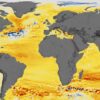A new study has highlighted how and when changes to the environment result in animal-borne disease thresholds being breeched, allowing for a better understanding and increased capacity to predict the risk of transmissions.
For the first time, researchers from Griffith University, Stanford University and the University of California used cumulative pressure mapping and machine learning to better understand how six vector-borne diseases (those transmitted by biting insects) found in different environments responded to the effects of human pressures.
Published in Nature Sustainability, the research found diseases associated with lower human pressure, including malaria, cutaneous leishmaniasis and visceral leishmaniasis, gave way to diseases associated with high human pressure, such as dengue, chikungunya and Zika.
Human impact on the Earth
“People are really good at modifying the Earth—as much as 95% of the Earth’s surface has been modified in some way by humans,” said Dr. Eloise Skinner, the study’s lead researcher from Griffith’s Centre for Planetary Health and Food Security.
“We know that when we modify the Earth’s surface we also change the species community, which includes plants, animals and insects.”
“What we haven’t known until recently is how these changes to species change the risk of disease to humans.”
Dr. Skinner said the findings enhance the ability to anticipate these transitions, would support a dynamic public healthcare infrastructure that could adapt to changes in disease occurrence through space and time.
Vector-borne diseases a global challenge
Vector-borne diseases (VBDs) are highly responsive to environmental changes, but such responses are notoriously difficult to isolate because pathogen transmission depends on a suite of ecological and social responses in vectors and hosts that may differ across species.
With more than half of the global population at risk of being infected with a VBD, Dr. Skinner and the team acknowledged how changes to environments impacted on each disease’s unique transmission cycle presented various complexities.
“Often, vectors and pathogens occupy their own unique niche, so that each transmission cycle responds distinctly to environmental change,” she said.
“With increasing human pressure, one would expect transitions in the occurrence of different diseases – for example, dengue is a highly urban pathogen while malaria occurs at the frontiers of deforestation.
“But how urban does an area have to be for dengue to become a risk? How much forest has to be converted before we start to see increases in malaria?”
These are some of the research questions the team sought answers to, to highlight the thresholds of land-use transitions that could lead to abrupt shifts in infectious disease burdens and public health needs.
Impact thresholds identified, a first
For the first time, the researchers were able to identify distinct thresholds of human impacts that specific diseases occupied.
Comparing across six vector-borne diseases in Brazil, the team found that in a critical window in which human footprint changed from moderate (4-7) to high (7-12) to intense (>12), disease occurrence abruptly shifted from malaria, cutaneous leishmaniasis, and visceral leishmaniasis to dengue, chikungunya, and Zika (arboviruses transmitted by the urban mosquito Aedes aegypti).
“These are diseases that require distinct responses in vector control, diagnostics, and environmental management,” Dr. Skinner said.
“Because biomedical and chemical approaches alone have failed to sustainably eliminate these diseases, managing the socio-ecological settings that promote pathogen transmission is a critical frontier for planetary health.”
“In conjunction with climatic pressures, human pressure presents a major risk for disease emergence and transmission and therefore a major threat to human and environmental well-being.”
“Brazil was an ideal case study for assessing human pressure on disease transmission because it is a large, ecologically and socio-economically diverse country that contains many biogeographic zones, intense and variable land use pressures, high incidence of multiple diseases with contrasting ecologies, and a longstanding nationwide disease surveillance system.”
More information:
Caroline Glidden, Human footprint is associated with shifts in the assemblages of major vector-borne diseases, Nature Sustainability (2023). DOI: 10.1038/s41893-023-01080-1. www.nature.com/articles/s41893-023-01080-1
Provided by
Griffith University
Citation:
Changing landscapes alter ‘disease-scapes’: Study (2023, March 13)



